Question bank
Chapter-1 Place Value
Q-1 Fill in the blanks:
Q-2 True or False:
Q-3 One word answer:
Q-4
Write the number names for these numbers.

Q-5
Form numbers :


Q-6
Form numbers shown on each the following abacus:

Q-7
Read the following numbers and write them in words :
(a) 1475 = ____________________________
(b) 6502 = ____________________________
(c) 3002 = ____________________________
(d) 5060 = _______________
Q-8
Write the place value of the coloured digits:
(a) 3542
(b) 8760
(c) 6153
(d) 5427
(e) 2386
(f) 9473
Q-9
Use the place value concepts to fill in the blanks boxes:

Q-10
Write the following in expanded form :
(a) 4273 = _____________________
(b) 9425 = _____________________
(c) 2408 = _____________________
(d) 3087 = _____________________
Q-11
Write the following in standard form:
(a) 6000 + 900 + 3 = ___________________
(b) 2000 + 500 + 70 + 8 = ___________________
(c) 4000 + 1 = ___________________
(d) 9000 + 20 + 5 = ____________________
Q-12
Read and write ‘>’, ‘<’or’=’ in box.

Q-13
Compare the numbers and write > or

Q-14
Circle the greatest number:

Q-15
Circle the smallest number :

Q-16
Arrange the following in increasing or ascending order:
(a) 5936, 4592, 7816 _______________
(b) 2486, 1578, 1069 _______________
(c) 6253, 6285, 6245 _______________
(d) 7695, 7563, 7670 _______________
Q-17
Arrange the following in decreasing or descending order :
(a) 8737, 8798, 8709
(b) 3605, 3625, 3025
(c) 9470, 9478, 9540
(d) 4506, 4598, 4525
Q-18
Build the greatest number using given digits :
(a) 4, 0, 2
(b) 6, 2, 8, 3
(c) 7, 2, 9, 1
(d) 9, 4, 7, 6
(e) 5, 0, 7, 2
(f) 8, 0, 6, 9
Q-19
Build the smallest number using given digits :
(a) 0, 2, 6
(b) 1, 0, 8, 4
(c) 3, 4, 1, 0
(d) 9, 8, 2, 5
(e) 5, 0, 9, 4
(f) 5, 2, 8, 1
Q-20
Fill in the blanks:
(a) The greatest four digit number using different digits.
(b) The smallest four digit number using different digits.
(c) The greatest four digit number.
(d) The smallest four digit number.
Q-21
Write the numbers in the boxes:
(a) 1 more than 4925
(b) 1 more than 2653
(c) 1 less than 3528
(d) 1less than 6317
(e) 10 more than 5216
(f) 10 more than 7920
(g) 10 less than 1956
(h) 10 less than 2865
(i) 100 more than 8405
(j) 100 less than 2189
(k) 1000 more than 6039
(l) 1000 less than 7508
Q-22
Write the number that comes just before.
(a) ______________ 5039
(b) ______________ 8147
(c) ____________ 2146
(d) ____________ 4653
(e) ___________ 9705
(f) _____________ 1358
Q-23
. Write the number that comes just after. One is done for you:
(a) 3287 ____________
(b) 1564 ______________
(c) 2948 ______________
(d) 9347 _____________
(e) 5127 ______________
(f) 2506 _______________
Q-24
Complete each of the following patterns:
(a) 3257, 3267, 3277 ______________ ______________
(b) 5945, 5946, 5947 ______________ ______________
(c) 2046, 3046, 4046 ______________ ______________
(d) 7152, 7252, 7352 ______________ ______________
(e) 8235, 8240, 8245 ______________ ______________
(f) 6200, 6300, 6400 ______________ ______________
Q-25
Round off to the nearest 10:
(a) 22 ________
(b) 38 ________
(c) 15________
(d) 74 ________
(e) 67 ________
(f) 46________
(g) 12 ________
(h) 45 ________
(i) 52________
(j) 33 ________
(k) 18 ________
(l) 27________
Q-26
Fill in the blanks:
(a) 37 is between _____and _____ .
(b) 25 is between _____ and _____.
(c) 54 is between _____and _____.
(d) 13 is between _____ and _____.
(e) 48 is between _____and _____.
(f) 76 is between _____ and _____.
(g) 89 is between _____and _____.
(h) 61 is between _____ and _____.
Q-27
Circle the even numbers :

Q-28
Circle the odd numbers :

Multiple Choice Questions
Q-1 We use __________ digits and place value to write numbers.
(i)
8(ii)
9(iii)
10Q-2 The hundreds in Two hundreds seventy-three is _________.
(i)
Two(ii)
seventy(iii)
threeQ-3 Tens in Two hundred seventy three is _________.
(i)
two(ii)
seventy(iii)
threeQ-4 Ones in Two hundred seventy three is _________.
(i)
two(ii)
seventy(iii)
threeChapter-2 Addition
Q-1 Fill in the blanks:
Q-2 True or False:
Q-3 One word answer:
Q-4 Addition
Q-5
Solve the following.
(a) 2492 + 5206
(b) 2195 + 5601
(c) 7223 + 2275
(d) 3280 + 6119
(e) 5305 + 1302
(f) 5424 + 2374
(g) 2463 + 3425
(h) 8210 + 1456
(i) 2222 + 3333
Q-6
Solve:







Q-7
Find the sum.

Q-8
Solve these.
(a) 384 + 224
(b) 434 + 195
(c) 594 + 238
(d) 948 + 386
(e) 429 + 876
(f) 548 + 987
(g) 734 + 498
(h) 395 + 776
(i) 262 + 397 + 343
(j) 328 + 296 + 362
Q-9
Find the sum.
Q-10
Add the following by breaking up the numbers.
(a) 13 + 25 = ________________________________
(b) 32 + 27 = ________________________________
(c) 16 + 32 = ________________________________
(d) 42 + 53 = ________________________________
(e) 25 + 43 = ________________________________
(f) 11 + 59 = ________________________________
Q-11
Add these by counting in tens.
(a) 62 + 36 = ________________________________
(b) 45 + 34 = ________________________________
(c) 25 + 32 = ________________________________
(d) 37 + 28 = ________________________________
(e) 142 + 23 = ________________________________
(f) 64 + 95 = ________________________________
Q-12
Add the following by using the hundreds chart.
(a) 78 + 13 = __________
(b) 64 + 95 = __________
(c) 37 + 28 = __________
(d) 58 + 61 = __________
(e) 23 + 53 = __________
(f) 26 + 57 = __________
Q-13
Add the following by any method you like.
(a) 44 + 26 = __________
(b) 72 + 14 = __________
(c) 26 + 67 = __________
(d) 45 + 34 = __________
(e) 56 + 28 = __________
(f) 68 + 72 = __________
Q-14
Solve the following
(a) 428 + 100
(b) 326 + 122
(c) 202 + 202
(d) 333 + 444
(e) 316 + 171
(f) 431 + 314
Q-15
Solve the following.
(a) 424 + 326
(b) 538 + 206
(c) 402 + 438
(d) 156 + 239
(e) 592 + 341
(f) 521 + 398
(g) 382 + 573
(h) 678 + 214
(i) 230 + 123 + 482
(j) 324 + 116 + 531
Q-16
Add the following numbers.

Q-17
Add the following numbers.

Q-18
Frame a word problem for each addition fact.
(a) 14 + 27 = ?
(b) 42 + 31 = ?
(c) 20 + 50 = ?
(d) 17 chocolates + 70 toffees = ?
(e) 125 men + 110 women = ?
Q-19
Each of the following problems has some extra information. Solve the problem.





Multiple Choice Questions
Q-1 When we put together two or more quantities, we use _________.
(i)
place value(ii)
addition(iii)
none of theseQ-2 There are a number of methods to add _________ mentally.
(i)
alphabet(ii)
numbers(iii)
none of theseQ-3 38+24=?
(i)
60(ii)
62(iii)
64Q-4 62+36=?
(i)
94(ii)
96(iii)
98Chapter-3 Subtraction
Q-1 Fill in the blanks:
Q-2 True or False:
Q-3 One word answer:
Q-4
Subtract the following by breaking up the numbers.
(a) 25 – 13 =_____________
(b) 45 – 23 = ___________
(c) 72 – 51 =_____________
(d) 52 – 21 = ___________
(e) 83 – 42 = _____________
(f) 62 – 41 = ____________
Q-5
Subtract the following by using the hundreds chart.
(a) 43 – 26 = __________
(b) 97 – 69 = __________
(c) 55 – 37 = __________
(d) 91 – 25 = __________
(e) 73 – 44 = __________
(f) 92 – 51 = __________
Q-6
Subtract these by counting backwards.
(a) 63 – 28 =_____________
(b) 90 – 35 = ___________
(c) 90 – 35 =_____________
(d) 82 – 53 = ___________
(e) 74 – 32 = _____________
(f) 95 – 47 = ____________
Q-7
Subtract the following by using any method you like.
(a) 68 – 35 = __________
(b) 95 – 43 =__________
(c) 43 – 34 = __________
(d) 91 – 63 = __________
(e) 67 – 28 = __________
(f) 52 – 21 = __________
Q-8
Find the difference for each of the following.

Q-9
Write the number in columns and subtract.

Q-10
Solve the following.
(a) 729 – 666 = ________
(b) 244 – 137 = ________
(c) 470 – 237 = ________
(d) 804 – 572 = ________
(e) 486 – 297 = ________
(f) 517 – 284 = ________
(g) 173 – 98 = ________
(h) 529 – 237 = ________
(i) 845 – 468 = ________
Q-11
Solve the following.
(a) 600 – 489 = ________
(b) 300 – 267 = ________
(c) 500 – 345 = ________
(d) 900 – 456 = ________
(e) 421 – 216 = ________
(f) 514 – 271 = ________
(g) 741 – 436 = ________
(h) 819 – 542 = ________
(i) 670 – 468 = ________
Q-12
Solve:

Q-13
Identify the sum and the add ends. Build subtraction facts using the same numbers.




Q-14
Find the difference.

Q-15
Solve the following.
(a) 5826 – 2514 = ______
(b) 7823 – 4612 = ______
(c) 6458 – 4216 = ______
(d) 9999 – 7777 = ______
(e) 8326 – 5215 = ______
(f) 2148 – 1036 = ______
Q-16
Estimate the numbers to the nearest tens and find the estimated sum.

Q-17
Estimate the numbers to the nearest tens and find the estimated diffrence.

Q-18
Solve using addition or subtraction. Estimate the answer first.

Q-19
Fill up the blanks.
(a) 72 + ___ = 85
(b) 25 + ___ = 56
(c) 27 + ___ = 59
(d) 39 + ___ = 51
(e) 28 + ___ = 68
(f) 28 + ___ = 67
(g) 72 – ___ = 29
(h) 57 – ___ = 42
(i) 61 – ___ = 33
(j) 55 – ___ = 18
(k) 96 – ___ = 8
(l) 81 – ___ = 43
Q-20
Solve:





Q-21
Frame a word problem for each of the subtraction sums given below.
(a) 113 – 25 = ?
(b) 45 – 29 = ?
(c) 122 – 31 = ?
(d) 415 – 399 = ?
(e) 345 – 296 = ?
(f) 57 – 48 = ?
Q-22
Solve:
1. Sumit had to travel 453 km. He travelled 215 km by train and 78 km by bus. He covered the remaining distance by car. What distance did he travel by car?
2. Tina’s mother gave her ` 300 for Christmas. Tina used ` 118 to buy a book and ` 20 to buy an ice-cream. How much money was left with her?
3. In July, there were 6 holidays. How many days did school remain open?
4. Mansi had 24 sweets. She got 13 more from her brother. She gave 18 to a friend. How many sweets did she have?
5. Suraj bought 80 Frooti packs and 60 Pepsi packs on his birthday. 48 of them were used up. How many soft drink packs were left?
6. A man bought 32 apples, 26 mangoes and 12 watermelons. Out of these, 23 fruits were rotten. How many fruits were fresh?
7. Sita has 129 stamps. Her friend gave her 54 more stamps. She pasted 72 stamps. How many more stamps are to be pasted in the album by Sita?
Multiple Choice Questions
Q-1 ___________ means taking away a set of objects from a group.
(i)
Subtraction(ii)
Addition(iii)
both of theseQ-2 The number of items left in a group after subtraction is called ___________.
(i)
addition(ii)
difference(iii)
none of theseQ-3 43-26=?
(i)
17(ii)
19(iii)
18Q-4 91-25=?
(i)
64(ii)
65(iii)
66Chapter-4 MultiPlication
Q-1 Fill in the blanks:
Q-2 True or False:
Q-3 One word answer:
Q-4
Find the product.
(a) 3 × 5 = ______
(b) 9 × 2 = ______
(c) 4 × 10 = ______
(d) 7 × 4 = ______
(e) 7 × 8 = ______
(f) 6 × 5 = ______
(g) 2 × 8 = ______
(h) 6 × 7 = ______
(i) 8 × 9 = ______
(j) 10 × 6 = ______
(k) 4 × 5 = ______
(l) 3 × 7 = ______
Q-5
Write the missing factors.
(a) 5 × ______ = 30
(b) ______ × 6 = 24
(c) 2 × ______ = 14
(d) ______ × 8 = 72
(e) ______ × 3 = 27
(f) 5 × ______ = 40
(g) 7 × ______ = 42
(h) ______ × 9 = 18
(i) 6 × ______ = 12
(j) 6 × ______ = 54
(k) 7 × ______ = 35
(l) 9 × ______ = 81
Q-6
Multiply.

Q-7
Find the product.

Q-8
Solve these sums.
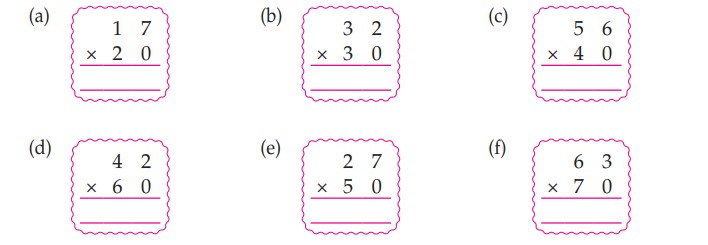
Q-9
Multiply.

Q-10
Find the missing numbers.

Q-11
Multiply the following numbers:

Q-12
Find the product by regrouping:

Q-13
Multiply the following numbers.

Q-14
Find the missing digit.

Q-15
Multiply the following numbers by using box multiplication.

Q-16
Multiply these numbers by using box multiplication.

Q-17
Find out those two numbers between which the product in each case should lie. Then solve.

Q-18
Estimate the product in each case. Then find the actual product.

Q-19
Find the product of each of the following numbers by lattice method.

Q-20
Multiply by filling up the lattice.
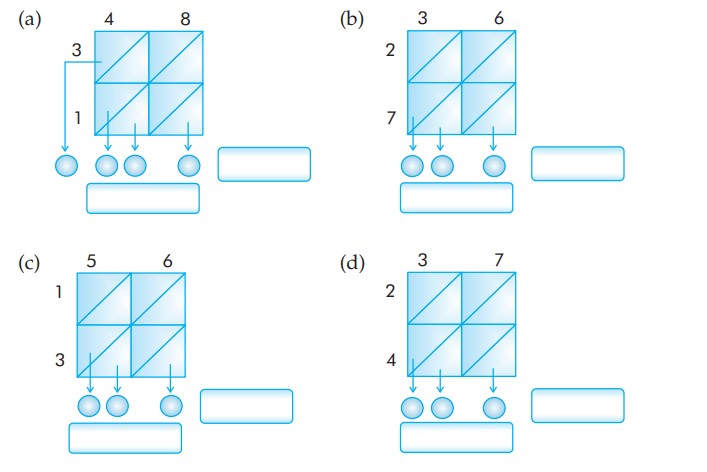
Q-21
Numericals:






Multiple Choice Questions
Q-1 3 groups of 4 flowers is _________ flowers.
(i)
7(ii)
10(iii)
12Q-2 We can use _______ in place of repeated addition to find out how many are there in all.
(i)
multiplication(ii)
subtraction(iii)
additionQ-3 There are ___________ sweets in 8 groups of 7 sweets each.
(i)
52(ii)
54(iii)
56Q-4 There are _________ sticks in 9 groups of 7 sticks each.
(i)
63(ii)
16(iii)
2Chapter-5 Division
Q-1 Fill in the blanks:
Q-2 True or False:
Q-3 One word answer:
Q-4
Put the mangoes in the baskets.

Q-5
Put the flowers into the pots.

Q-6
Put the notes of 50 rupees into the purses.

Q-7
Write the quotient for each of the following:




Q-8
Solve these by repeated subtraction.

Q-9
Find the quotient in each of the following:




Q-10
Fill up the blanks.

Q-11
Fill up the blanks.

Q-12
Fill up the following blanks.

Q-13
Write two division facts using multiplication facts.

Multiple Choice Questions
Q-1 A week has 7 days. How many weeks will 35 days make?
(i)
16(ii)
5Q-2 Kapil has 20 pencils. If a box can hold 5 pencils, how many boxes will he need for keeping all his pencils?
(i)
4(ii)
5(iii)
15Q-3 A string can contain 5 beads. How many such strings will be needed for 25 beads?
(i)
20(ii)
30(iii)
5Q-4 Grima has 28 toffees. If only 4 sweets can be put in a packet, how many such packets are needed to pack all the toffees?
(i)
32(ii)
24(iii)
7Chapter-6 More About Division
Q-1 Fill in the blanks:
Q-2
Solve the following by using the long form of division:

Q-3
Solve these:
(a) Divide 10 pencils into groups of 4. Number of groups = ___________ Left over = ___________
(b) Divide 21 butterflies into groups of 5. Number of groups = ___________ Left over = ___________
(c) Divide 25 glasses into groups of 6. Number of groups = ___________ Left over = ___________
Q-4
Find the quotient and remainder by using long division:

Q-5
Answer in 'Yes' or 'No':
(a) Can a divisor of 3 have a remainder of 5?
(b) Can a divisor of 8 have a remainder of 4?
(c) Can a divisor of 2 have a remainder of 2?
(d) Can a divisor of 7 have a remainder of 11?
Q-6
Solve these by using method 1:

Q-7
Solve these by using method 2:

Q-8
Use any method to divide the following and check your answer:

Q-9
Use any method to divide.

Q-10
Divide using any method and check your answer.

Multiple Choice Questions
Q-1 When we divide a number, we may not be able to _________ it exactly.
(i)
add(ii)
divide(iii)
multiplyQ-2 The number which is left over in division is called the _________.
(i)
divisor(ii)
dividend(iii)
remainderQ-3 We write the remainder at the ______.
(i)
top(ii)
bottom(iii)
endQ-4 The remainder must always be _____ than the divisor.
(i)
larger(ii)
smaller(iii)
biggerChapter-7 Fractions
Q-1 Fill in the blanks:
Q-2 True or False:
Q-3 One word answer:
Q-4
Put tick (/) for equal parts and cross (X) for unequal parts

Q-5
Find 4 different ways to divide these squares into half.

Q-6
Join the dots of the other half and colour it.

Q-7
Write the fractions for the shaded parts. One is done for you:

Q-8
Write two fractions for each as shown:

Q-9
Circle the correct fraction to show the part of container filled with liquid.
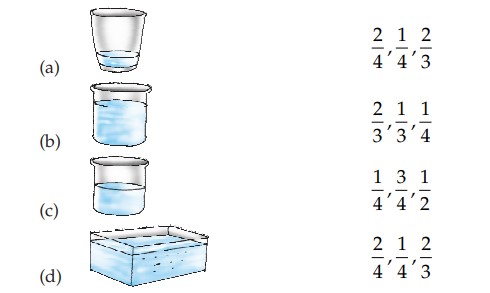
Q-10
Fill in the boxes with the correct fraction.

Q-11
. Fill in the boxes with the correct fraction.

Q-12
Point out the numerator (N) and the denominator (D) in the following fractions:

Q-13
Write fraction with:
(a) 5 as numerator and 7 as denominator
(b) 3 as numerator and 4 as denominator
(c) 4 as numerator and 5 as denominator
(d) 1 as numerator and 5 as denominator
Multiple Choice Questions
Q-1 A whole object can be divided into any number of parts or __________.
(i)
division(ii)
Fractions(iii)
none of theseQ-2 Fractional parts can be __________.
(i)
equal(ii)
unequal(iii)
both of theseQ-3 One half of a whole can be written as _______.
(i)
1/2(ii)
3/2(iii)
5/2Q-4 _______ halves make a whole.
(i)
Two(ii)
three(iii)
FourChapter-8 Shapes, Patterns And Symmetry
Q-1 Fill in the blanks:
Q-2 True or False:
Q-3 One word answer:
Q-4
Look at the dots given below; complete the shapes to make squares, rectangles and spheres.

Q-5
Look at the following objects and fill up the blanks:

Q-6
Make your own shape by using the 7 pieces of a tangram.
Q-7
Fill up the blanks.
(a) A square has 4 _________ and 4 corners.
(b) A _________ is a flat surface of a solid shape.
(c) At the corner three _________ meet.
(d) An edge can be a straight or a _________ line.
(e) Solid shapes may have corners, edges and _________ .
(f) A sphere is _________ in shape.
(g) In a cone, one _________ is plane and the other is curved.
(h) In a cuboid, every face is _________ .
Q-8
State True or False.
(a) A triangle has 4 sides.
(b) A circle has 4 corners.
(c) A square has 4 sides.
(d) A cone has 2 faces and 1 edge.
(e) In a cuboid, every face is square.
(f) In a cylinder, two faces are plane.
(g) A cube has 6 faces.
(h) A cuboid has 12 edges.
Q-9
Look at the following patterns and draw the next one:

Q-10
. Look at the patterns given below and draw the next one:




Q-11
Observe the patterns given below and write the next number for each pattern:
(a) 1 2 5 10 17 26 .................
(b) 102 104 106 108 110 112 .................
(c) 20 40 80 160 ................. .................
(d) 75 90 105 120 ................. .................
Q-12
Which of the following are tile designs?

Q-13
Make your own design and colour it.

Q-14
Make tile designs by using the given shapes.

Multiple Choice Questions
Q-1 A square has _______ corners.
(i)
two(ii)
three(iii)
fourQ-2 A triangle has ______ sides.
(i)
three(ii)
four(iii)
fiveQ-3 A triangle has _________ corners.
(i)
four(ii)
five(iii)
threeQ-4 A rectangle has ____________ sides.
(i)
three(ii)
four(iii)
fiveChapter-9 Measurements
Q-1 Fill in the blanks:
Q-2 True or False:
Q-3 One word answer:
Q-4
Convert the following into cm:

Q-5
Measure the following objects by using the centimetre ruler:

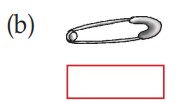



Q-6
Encircle the closest answer.

Q-7
What would you use cm, m, km to measure the following:
(a) Length of a wood stick _______________
(b) Height of the building _______________
(c) Length of a sofa _______________
(d) Length of river Ganga _______________
(e) Length of a knife _______________
(f) Height of a juice container ____________
(g) Length of a sharpener _______________
(h) Length of an aeroplane _______________
(i) Height of a tree _______________
(j) Length of a desk _______________
(k) Length of a painting brush ____________
Q-8
. Draw a circle on the closest answer.
(a) Distance between market and home. 6 m/6 km
(b) Height of an electricity pole. 4 m/4 km
(c) Length of a carpet. 5 m/5 km
(d) Height of a building. 10 m/10 km
(e) Length of a train. 1 m/1 km
(f) Length of a shoe lace. 20 cm/20 m
(g) Length of a mobile phone. 10 cm/10 m
(h) Length of a floor. 8 m/8 km
(i) Height of a window. 1 m/1 km
(j) Length of a sheet of paper. 25 cm/25 m
(k) Length of a scooter. 2 cm/2 m
(l) Distance between the banks of a river. 1 cm/1 km
Q-9
Study the map given below and answers to the following questions:

(a) If Divya has to go to the shopping mall from her home, what is the best way for her to go there?
(b) What is the shortest way from Kavita’s home to Divya home?
(c) What is the shortest way from school to the swimming pool?
(d) What is the shortest distance between the shopping mall and the railway station?
Q-10
Circle the weights that you will need to weigh the following objects:



Q-11
Write the weight of each of the following objects:
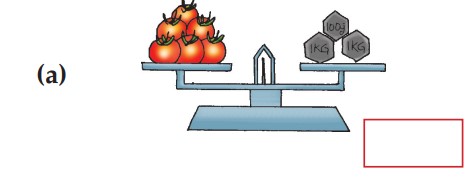

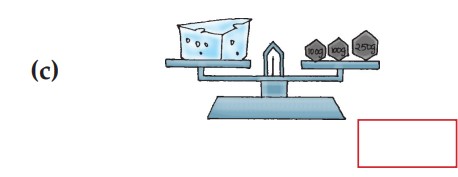

Q-12
Encircle the most likely weight.

Q-13
Put a tick (/) on the most likely measurement.

Q-14
What would you use – mL or L – to measure each the following:
(a) Quantity of juice in a bottle .......................
(b) Quantity of cold cream in a tube .......................
(c) Quantity of oil in a tin .......................
(d) Quantity of coke in a bottle .......................
(e) Quantity of water in a mug .......................
(f) Quantity of water in a drum .......................
Q-15
Circle the glasses that you will need to fill up the following vessels:

Multiple Choice Questions
Q-1 We use ___________ to measure shorter lengths.
(i)
centimetres(ii)
metres(iii)
gramsQ-2 We use ________ to measure longer lengths.
(i)
centimetres(ii)
metres(iii)
gramsQ-3 We use ________ to weigh lighter objects.
(i)
grams(ii)
kilograms(iii)
none of theseQ-4 We use ________ to weigh heavier objects.
(i)
kilograms(ii)
grams(iii)
none of theseChapter-10 Time
Q-1 Fill in the blanks:
Q-2 True or False:
Q-3 One word answer:
Q-4
Shade the minutes that have passed. Write the time.


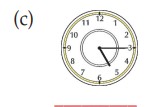





Q-5
Write the time.

Q-6
Give the time in two ways.

Q-7
Encircle the closest answer.
(a) Listening some music on a cassette [1 minute/1 hour]
(b) Going to school [30 minutes/30 hours]
(c) Learning a lesson [2 minutes/2 hours]
(d) From the rainy to summer season [weeks/months]
(e) Growth of a plant from a seed [days/weeks]
(f) For a puppy to become a dog [months/years]
Q-8
Look at the calendar of the year 2023.
Answer the following questions :
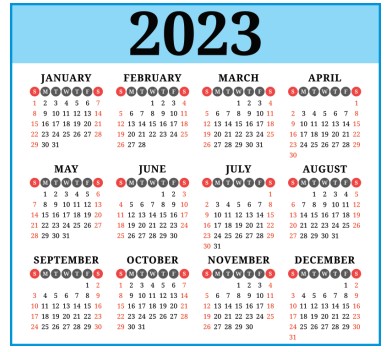
(a) How many Sundays are there in year 2023?
(b) On which date does Christmas fall?
(c) Which day of the week is the fifteenth day in August?
(d) On which day does the year 2023 begin?
(e) On which day does your birthday fall?
(f) Find the number of days from 28th May to 5th September (both days included).
Q-9
Write the date in both the formats of the year 2023. One has been done for you.
(a) Fifth day of the seventh month
(b) Twenty-third day of the fifth month
(c) Fourteenth day of the second month
(d) Twenty-first day of the sixth month
Q-10
Make a timeline of your friend. Write information about when he walked, his first day at school, his age at present time.
Q-11
Make a timeline of yourself.
Q-12
Make a timeline of the given events in Madhu’s life.
(a) She learnt to speak at the age of 3 years.
(b) She got her first tooth at the age of 8 months.
(c) She learnt to sit at the age of 7 months.
Multiple Choice Questions
Q-1 _________ minutes make an hour.
(i)
30(ii)
50(iii)
60Q-2 The long hand of a clock is the ________ hand.
(i)
minute(ii)
hour(iii)
none of theseQ-3 The short hand is the _______ hand.
(i)
minute(ii)
hour(iii)
none of theseQ-4 The hour hand takes ___________ hour to move from one number to the next.
(i)
one(ii)
two(iii)
threeChapter-11 Money
Q-1 Fill in the blanks:
Q-2 True or False:
Q-3 One word answer:
Q-4
Find the total value of each collection of notes and coins.

Q-5
Nidhi, Meenakshi, Neerja and Rajni went shopping. Each one carried certain amount of money. Can you count and tell how much money did each one have?




Q-6
Add the following.

Q-7
Copy and add.

Q-8
Akash, Vikas, Tanu and Rohit carried certain amount of money to shop. Each one donated ` 20 each for the Rehabilitation Centre. How much money did they donate separately and how much money was left with them?

Q-9
Subtract the following.

Q-10
Copy and subtract.

Q-11
Multiply.

Q-12
Copy and multiply.

Q-13
Divide.

Q-14
Solve:
Sanjana bought birthday presents for two of her friends. One costs Rs.60.50 and the other Rs.72.25. How much did she spend on the presents?
Q-15
Solve:
Shalini has Rs.45.50. How much money will be left with her if she spends Rs.26.75 for a book?
Q-16
Solve:
Anshul bought one toy for Rs.30.25. Six of his friends bought the same toy. How much did all the toys cost together?
Q-17
Solve:
Four garden chairs cost Rs.148. How much does each chair cost?
Q-18
Solve:
Sneha bought talcum powder for Rs.77.50. If she took Rs.100 to the shop, how much amount was left with her?
Q-19
Solve:
On a trip, 6 boys spent Rs.123.18. How much money did each boy spend?
Multiple Choice Questions
Q-1 1 rupee is equals to _______ paise.
(i)
50(ii)
70(iii)
100Q-2 Ritu has Rs. 54.25. Her mother gave her Rs. 24.25 more. How much money did Ritu now have?
(i)
78.50(ii)
70(iii)
65Q-3 One notebook costs Rs. 12.50. How much do 6 notebooks cost?
(i)
70.00(ii)
75.00(iii)
65Q-4 Reena spends Rs. 95.50 on gifts for her mother. Her brother spends Rs. 72.25. How much more money does she spend than her brother?
(i)
Rs. 23.25(ii)
Rs. 22.25(iii)
Rs. 21.25